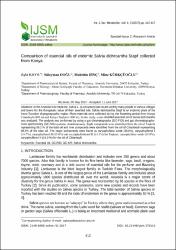| dc.contributor.author | Kaya, Ayla | |
| dc.contributor.author | Doğu, Süleyman | |
| dc.contributor.author | Dinç, Muhittin | |
| dc.date.accessioned | 2019-10-19T14:44:14Z | |
| dc.date.available | 2019-10-19T14:44:14Z | |
| dc.date.issued | 2017 | |
| dc.identifier.issn | 2148-6905 | |
| dc.identifier.uri | http://www.trdizin.gov.tr/publication/paper/detail/TWpVMU9UY3hNUT09 | |
| dc.identifier.uri | https://hdl.handle.net/11421/13452 | |
| dc.description.abstract | In the Anatolia folk medicine, Salvia L. (Lamiaceae) species are used by many people in various villages and towns for the therapeutic value of their essential oils. Salvia dichroantha Stapf is an endemic plant of the Irano-Turanian phytogeographic region. Plant materials were collected during the flowering period from Konya Cihanbeyli (900 m) and Konya Taşkent (1800 m). In this study, water-distilled essential oil of Salvia dichroantha was analyzed. The analysis was performed by using a gas chromatography (GC-FID) and gas chromatographymass spectrometry (GC-MS) systems, simultaneously. Eight compounds were identified from the oil of Taşkent representing 96.2 % of the total oil and nine compounds were identified from the oil of Cihanbeyli representing 98.3% of the total oil. The major components were found as caryophyllene oxide (38.6%), caryophyllenol I (16.7%), caryophyllenol II (15.6%) and caryophylladienol II (11.1%) for Taşkent; caryophyllene oxide (65.8%), caryophyllenol II (14.3 %) for the oil of Cihanbeyli. | en_US |
| dc.description.abstract | In the Anatolia folk medicine, Salvia L. (Lamiaceae) species are used by many people in various villages and towns for the therapeutic value of their essential oils. Salvia dichroantha Stapf is an endemic plant of the Irano-Turanian phytogeographic region. Plant materials were collected during the flowering period from Konya Cihanbeyli (900 m) and Konya Taşkent (1800 m). In this study, water-distilled essential oil of Salvia dichroantha was analyzed. The analysis was performed by using a gas chromatography (GC-FID) and gas chromatographymass spectrometry (GC-MS) systems, simultaneously. Eight compounds were identified from the oil of Taşkent representing 96.2 % of the total oil and nine compounds were identified from the oil of Cihanbeyli representing 98.3% of the total oil. The major components were found as caryophyllene oxide (38.6%), caryophyllenol I (16.7%), caryophyllenol II (15.6%) and caryophylladienol II (11.1%) for Taşkent; caryophyllene oxide (65.8%), caryophyllenol II (14.3 %) for the oil of Cihanbeyli. | en_US |
| dc.language.iso | eng | en_US |
| dc.rights | info:eu-repo/semantics/openAccess | en_US |
| dc.subject | Biyoloji | en_US |
| dc.title | Comparison of essential oils of endemic Salvia dichroantha Stapf collected from Konya | en_US |
| dc.type | article | en_US |
| dc.relation.journal | International Journal of Secondary Metabolite | en_US |
| dc.contributor.department | Anadolu Üniversitesi, Eczacılık Fakültesi, Farmasötik Biyoteknoloji Anabilim Dalı | en_US |
| dc.identifier.volume | 4 | en_US |
| dc.identifier.issue | 3 | en_US |
| dc.identifier.startpage | 412 | en_US |
| dc.identifier.endpage | 417 | en_US |
| dc.relation.publicationcategory | Makale - Ulusal Hakemli Dergi - Kurum Öğretim Elemanı | en_US |
| dc.contributor.institutionauthor | Kaya, Ayla | |
| dc.contributor.institutionauthor | Kürkçüoğlu, Mine | |


















